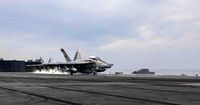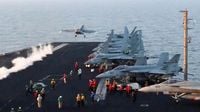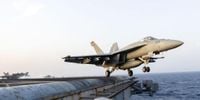On Monday, April 28, 2025, a U.S. Navy F/A-18E Super Hornet fighter jet fell off the USS Harry S. Truman aircraft carrier and sank into the Red Sea, marking a significant incident amid ongoing military operations in the region. The aircraft, valued at approximately $60 million, was being towed in the hangar bay when the crew lost control, resulting in the mishap that left one sailor with a minor injury.
The incident occurred as the USS Harry S. Truman was conducting evasive maneuvers to avoid incoming fire from Houthi militants in Yemen. Initial reports suggest that the carrier made a sharp turn to evade missiles, which may have contributed to the loss of control over the aircraft. According to a U.S. official, "the F/A-18E was actively under tow in the hangar bay when the move crew lost control of the aircraft. The aircraft and tow tractor were lost overboard." Fortunately, all personnel aboard the aircraft were able to jump to safety before it fell into the sea.
The USS Harry S. Truman has been deployed in the Red Sea since September 2024, primarily to protect commercial shipping from Houthi attacks. The carrier strike group, which includes nine squadrons of Carrier Air Wing 1 and several guided-missile destroyers, remains fully mission capable despite the incident. The Navy emphasized that the aircraft's loss does not impair the operational readiness of the strike group.
This mishap is not the first for the Truman; earlier this year, the carrier collided with a merchant ship near the Suez Canal, resulting in the firing of its commanding officer. Furthermore, on December 21, 2024, a different F/A-18 Super Hornet from the Truman was accidentally shot down by the USS Gettysburg in what was described as an apparent case of friendly fire. Both pilots ejected safely during that incident.
The U.S. military has been engaged in a significant air campaign against the Houthi rebels since mid-March 2025, conducting daily strikes that have reportedly resulted in the deaths of at least 500 Houthi fighters. Despite the ongoing operations, the U.S. has remained tight-lipped about the campaign's overall effectiveness. The Houthis have claimed responsibility for attacks against U.S. military assets in the region, including the missile and drone strikes that reportedly prompted the Truman's evasive maneuvers on the day of the incident.
In recent months, the U.S. has also lost several MQ-9 Reaper drones, valued at around $30 million each, to Houthi fire. The situation in the Red Sea has escalated, with the Houthis launching numerous missile and drone attacks against both commercial and military vessels. This period has been described as the U.S. Navy's heaviest sustained combat since World War II, with carrier-based fighter squadrons conducting hundreds of sorties over the past year.
The Navy has extensive experience in recovering lost aircraft and is expected to initiate a recovery effort for the F/A-18E Super Hornet. The importance of retrieving the aircraft lies not only in the financial loss but also in preventing adversaries from gaining access to its advanced technology. In recent years, the Navy has successfully recovered other aircraft, including a Navy F-35C that crashed in the Indo-Pacific and a Royal Navy F-35B that went down in the Mediterranean.
As the investigation into the incident continues, the Navy will be looking into the factors that led to the loss of the fighter jet, particularly the role of the sudden evasive maneuvers made by the Truman to avoid Houthi fire. The incident highlights the precarious nature of operations in a conflict zone where both military and environmental factors can lead to unexpected accidents.
In summary, while the loss of the F/A-18E Super Hornet is a setback, the U.S. Navy remains committed to its mission in the Red Sea. The ongoing operations against the Houthis underscore the complex and dangerous environment in which U.S. forces are operating, as they strive to protect international shipping and counter threats from Iranian-backed militants.






